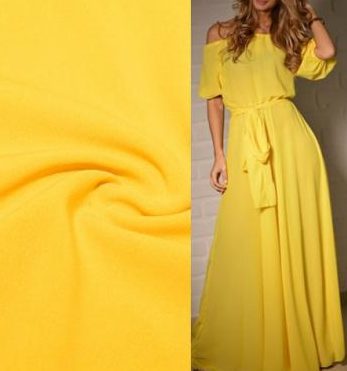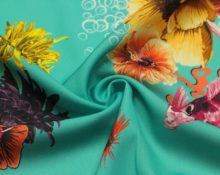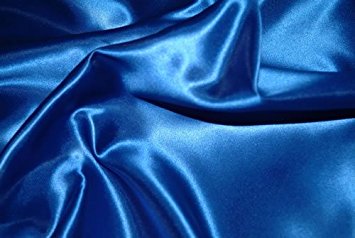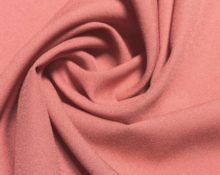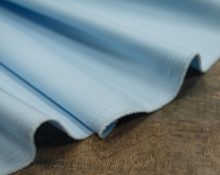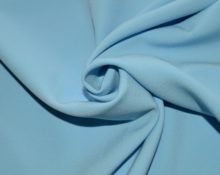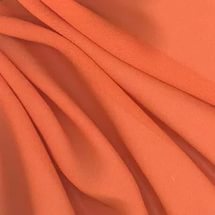 In spring and summer we prefer thin, airy materials. They are very comfortable, pleasant to the touch, and have high breathability. One of the most sought after and popular fabrics is crepe chiffon.
In spring and summer we prefer thin, airy materials. They are very comfortable, pleasant to the touch, and have high breathability. One of the most sought after and popular fabrics is crepe chiffon.
Composition, properties and description of crepe chiffon
This is a material with a grainy pattern. Thanks to the technological feature, a unique structure is created when spinning threads. Crepe chiffon involves the use of maximum twisting of threads and a special type of weave. Because of this, this fabric acquires density and original texture.
The composition of crepe chiffon may include silk fibers in varying quantities: wool, cotton threads, sometimes natural fibers with the addition of synthetic polyester are used.
The fabric is almost opaque, but very durable and light. Thanks to this feature of the material, it is used for flowing things and drapes well in folds.When sewing items from crepe-satin, the seamstress easily creates pintucks, waves, and folds with volume without adding weight. This draping of the product does not look deliberate or intrusive. In the classic design, the surface of crepe-satin is matte.
The fabric is double-sided, it is quite difficult to visually understand where the front side is and where the back side is, so things can be worn on either side. This property of the material is often taken into account by designers when sewing things.
Peculiarities
 two threads of raw silk are twisted in opposite directions: left and right. There are up to three thousand revolutions per meter of fabric;
two threads of raw silk are twisted in opposite directions: left and right. There are up to three thousand revolutions per meter of fabric;- After “twisting”, the fibers are intertwined like a fabric, which gives strength. This is a plain weave material;
- Another weaving technology can be used - crepe. There are two options: extending the overlap or applying satin weave to the twill. As a rule, they are almost not used when making crepe chiffon;
- after this, the fabric is exposed to high temperatures, under the influence of which the threads straighten and the material becomes more granular;
- average density: 25–35 g/m. This is less than other crepe weave fabrics.
Does it stretch or not?
Due to the special technology of weaving threads and twisting them, the fabric is tight and doesn't stretch. The material is not elastic and dense.
This point should be taken into account when sewing things from this material.
Crepe chiffon bubble
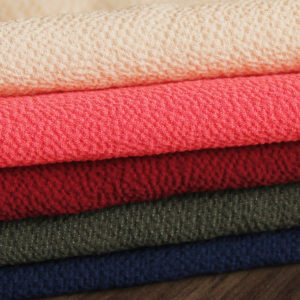 This is know-how in the textile market, so this material is an infrequent guest in retail outlets and online stores, despite the great popularity of chiffon. Crepe chiffon bubble is a light, airy synthetic material characterized by a special structure and porosity.
This is know-how in the textile market, so this material is an infrequent guest in retail outlets and online stores, despite the great popularity of chiffon. Crepe chiffon bubble is a light, airy synthetic material characterized by a special structure and porosity.
The material differs from ordinary crepe chiffon in the special bubble weaving of the fabric, which gives it a unique relief structure and graininess. Its surface is matte, without shine, with many small bubbles.
It has an original structure, perfect for sewing clothes, both for holidays and for everyday wear.
Varieties of crepe chiffon
What makes chiffon especially popular is its diversity, because items made from this material can be worn both in summer and winter, worn for everyday wear and used for a festive outfit.
What types of crepe chiffon exist:
- with spraying;
- bleached chiffon;
- crepe chiffon interspersed with lurex.
These fabrics go well with materials of the same type and opposite ones (knitwear, artificial and natural leather, fur). Fashionistas often use a combination with smooth shiny satin to create an evening look.
For everyday wear, combination with cotton fabrics, linen, denim, etc. is good.
Transparency (see-through or not)
Due to its dense structure, the fabric is practically non-transparent, unlike its predecessor - chiffon, which is lightweight and transparent.
Advantages and disadvantages
Like any material, crepe chiffon has a number of advantages and disadvantages.
Pros:
- The fabric is airy, but quite dense
- Double sided material
- Texture: grainy
- Resistant to mechanical damage, including rupture
- Many colors and prints
- Doesn't shine through
- Pleasant to the touch
- When washed, the material does not fade or fade
- Drapes beautifully
- Does not irritate the skin
Some sources write about the healing properties of this fabric, but this is nothing more than a ploy by marketers who are trying to make additional sales. Let's try to figure out what is a lie and what is true.
 The fabric actually contains a lot of protein. At their core, these are amino acid residues. Theoretically, they can have a positive effect on blood microcirculation, stabilize the gastrointestinal tract and have other positive effects on the body. But for such an effect, the tissue must be eaten for a long time. Of course, such use of the fabric is not intended by the consumer, and when wearing items made of crepe-chiffon, the impact on health is minimal.
The fabric actually contains a lot of protein. At their core, these are amino acid residues. Theoretically, they can have a positive effect on blood microcirculation, stabilize the gastrointestinal tract and have other positive effects on the body. But for such an effect, the tissue must be eaten for a long time. Of course, such use of the fabric is not intended by the consumer, and when wearing items made of crepe-chiffon, the impact on health is minimal.
Another "duck" - this is the restoration of a person’s skin from wearing something containing silk fibers. In reality, crepe chiffon does not have such properties. It can remove moisture from the body, absorb it, it does not irritate the skin and does not cause allergic reactions.
Minuses:
- Not very easy to handle, may slip
- Shrinks during washing
- If silk fibers are used in production, then the items need special care.
Proper care of crepe chiffon
In general, it is not recommended to wash items made from crepe chiffon., especially if the item has complex drapery. It is best to have it cleaned by a professional dry cleaner.
But if this is not possible or time is very expensive, you can wash it by hand. At the same time, using the basic rules for delicate fabrics:
- water should be no more than 30 degrees;
- colored items are washed separately from white ones;
- the product is not twisted or wrung out at high speeds in a washing machine;
- Do not rub the material too hard when washing so as not to damage the fibers
- do not bleach
You should dry things by laying them out on a horizontal surface (table, drying rack, sofa) or placing a terry towel under them. The towel will quickly collect excess water and the item will dry much faster. It is not recommended to dry clothes in an automatic washing machine.
The material hardly wrinkles, so it is not necessary to iron it. But if creases appear on the product, then a number of rules should be followed when ironing.
- set the “Silk” mode;
- check the temperature of the iron soleplate in an inconspicuous place;
- do not hold a hot iron in the same area for a long time to avoid scorching;
- To ensure that the fabric does not lose its decorative appearance for a long time, ironing through dry gauze is recommended.
Conclusions from the article
 Crepe chiffon is one of the most popular materials used for sewing women's clothing and decoration (making frills, bows, flounces, cuffs). But when sewing things from this material, you must remember that after washing the product may shrink slightly. The canvas practically does not stretch and does not lose its shape when deformed.
Crepe chiffon is one of the most popular materials used for sewing women's clothing and decoration (making frills, bows, flounces, cuffs). But when sewing things from this material, you must remember that after washing the product may shrink slightly. The canvas practically does not stretch and does not lose its shape when deformed.
This material is often used for sewing carnival or concert costumes. Most often these are dresses with an abundance of decorative details and original drapery. In the summer, things made of crepe chiffon keep cool well, which makes them comfortable to wear.
Despite all its unpretentiousness and strength, sewing from it is not at all easy. It crawls on the cutter’s table, diverges, and must be cared for like a delicate fabric. It should include ironing only from the back side (it is possible from the front side, but only through dry gauze). Iron the fabric slightly damp, and the temperature of the iron sole should not exceed 130–150 degrees.
And crepe chiffon does not withstand exposure to sunlight very well, especially when things are stored or begin to dry. If after washing the fabric has become more faded, it is recommended to restore the colors using a solution of water and vinegar. This composition, when rinsed, will help restore dull shades. But you should not pour vinegar into water, because you can damage the fibers, which will affect the wear resistance of the material.
Despite its capriciousness in care, the advantages outweigh all the disadvantages. That is why almost every woman tries to have at least one item made of crepe chiffon with beautiful trim and drapery in her wardrobe. The delicate flowing fabric of dresses makes women even more beautiful, allowing them to hide figure flaws and highlight their advantages.


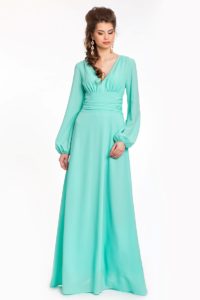
 0
0